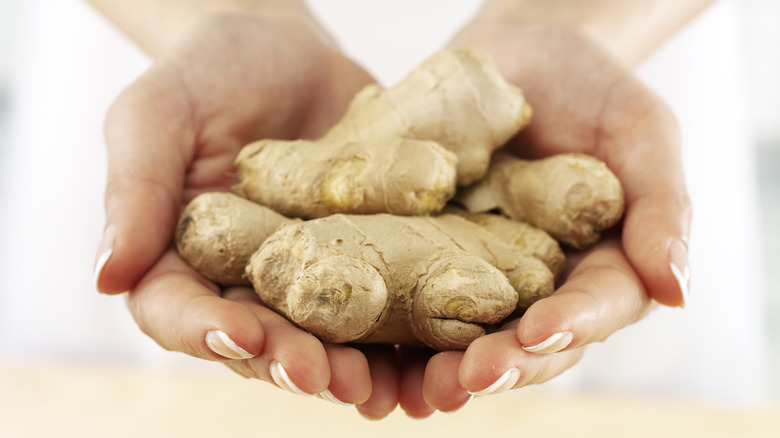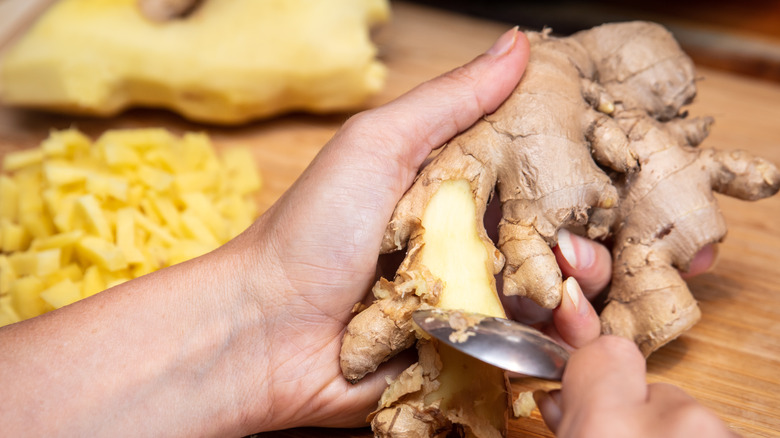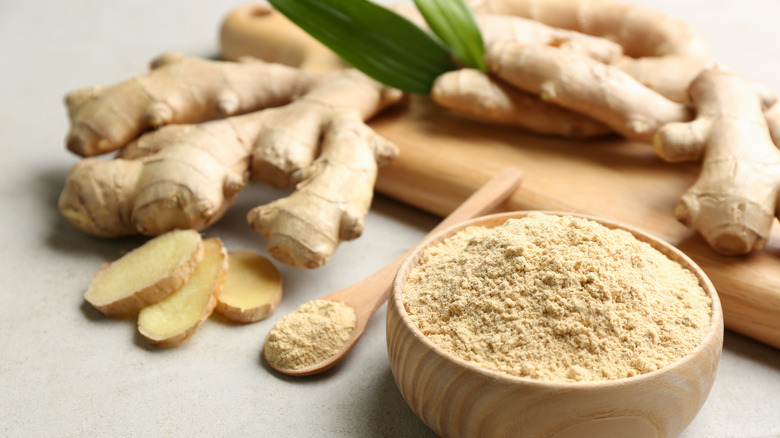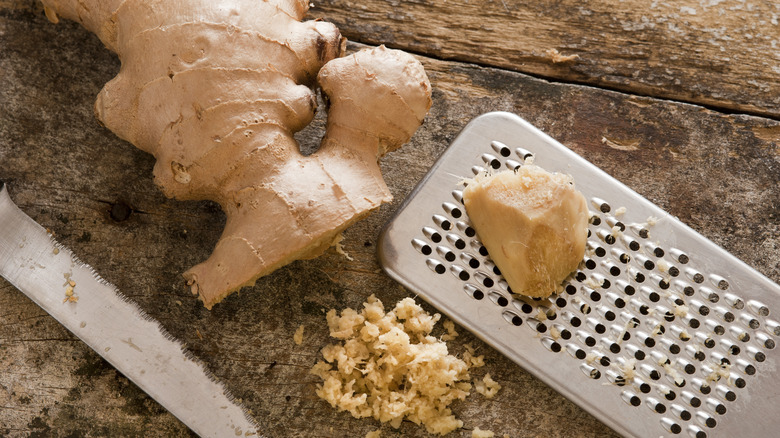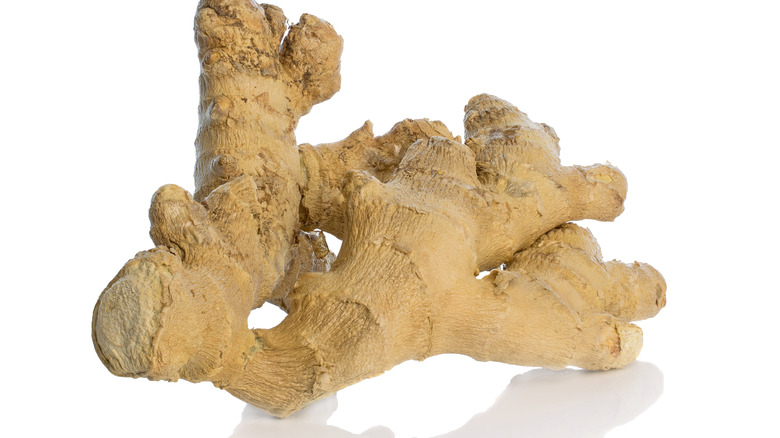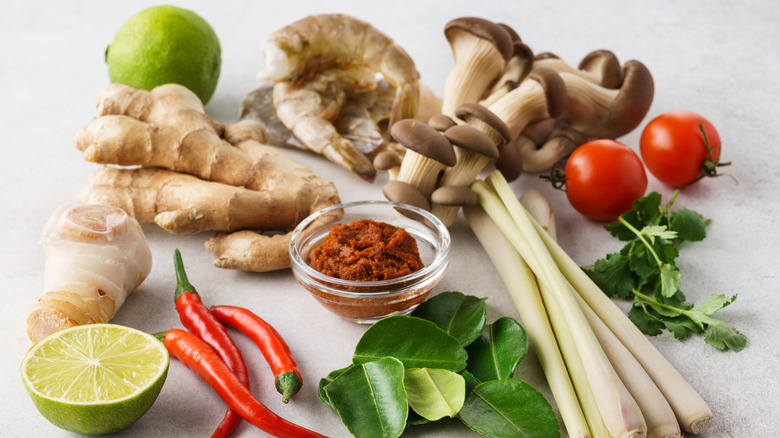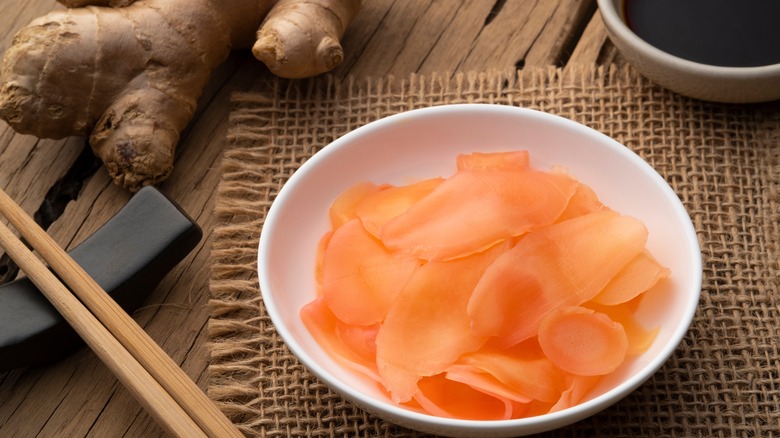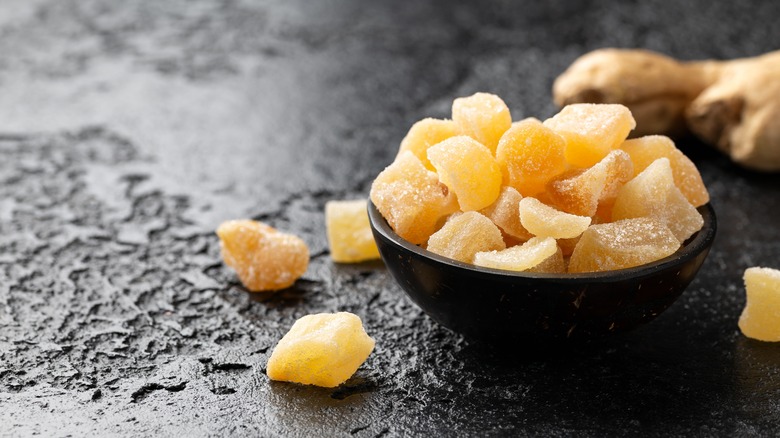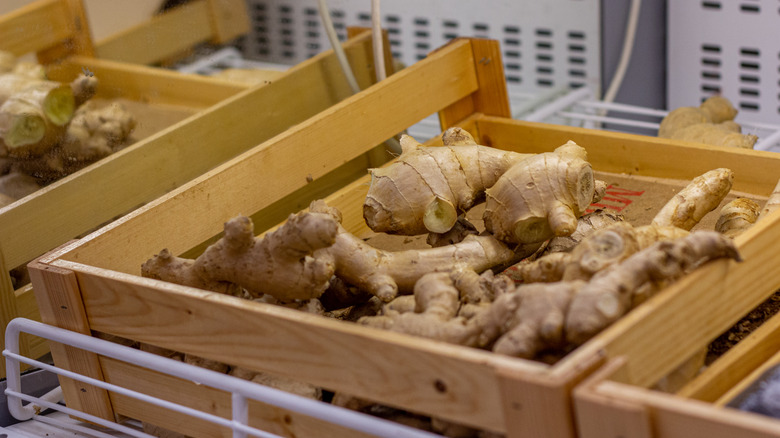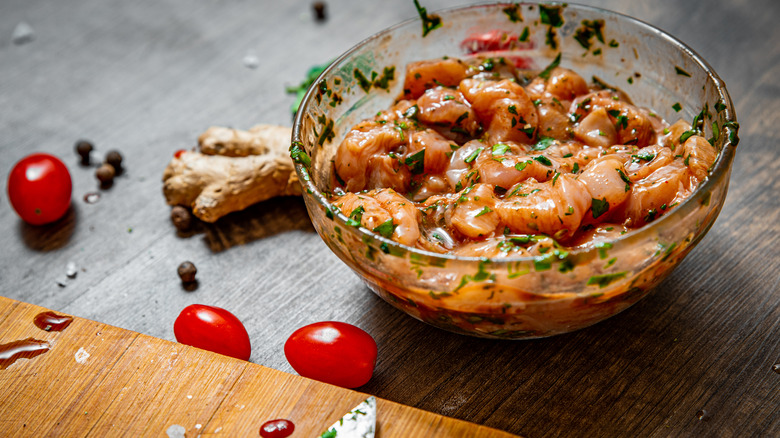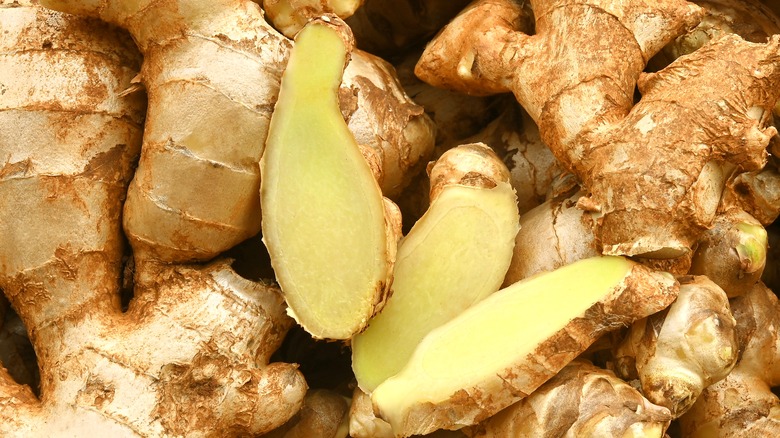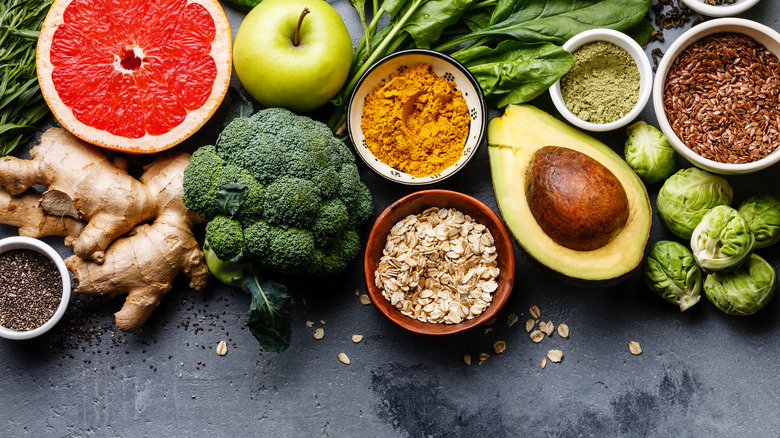Mistakes Everyone Makes When Cooking With Ginger
Though it may look like a knobby hand and fingers, ginger root is a plant rhizome that has become a global culinary star, known for its fiery flavor and uses in traditional medicine. Originating in southern China, ginger can now be found in grocery stores worldwide and has made its way into the hearts of home cooks everywhere.
Found in many cuisines in both its fresh and ground form, ginger enhances the flavor of various dishes, from curries and sushi to baked goods and even beverages. However, ginger is sometimes misunderstood, and amateur chefs often fail to use its full potential. Some cooks might be intimidated by its appearance and difficulty of preparation, while others may not appreciate how to balance ginger with other flavors.
Join us as we explore the common mistakes people make when cooking with this amazing root, from storing it incorrectly to underutilizing it in weekly meals. By avoiding these pitfalls, you can let the ginger shine in your cooking and enjoy its warming flavor and myriad health benefits.
Overpeeling ginger
If you have ever tried peeling ginger, you know it is no easy task. It usually results in half the root wasted — and you might nearly slice your finger off. But have you wondered why we bother peeling ginger in the first place? Its skin is paper thin and, when cooked, is undetectable in the final dish. If Jamie Oliver is telling us not to bother peeling our butternut squash, with its thick, tough skin, then surely we can leave the delicate skin of ginger intact?
Ultimately, it is up to you if you feel the need to peel your ginger or not. If it is organic, there is no reason to get rid of the skin — it's time-consuming, and that time can be better spent preparing other ingredients in your dish. If the ginger is not organic, you may want to take off the skin, saving as much of the flesh as possible. In this case, you will need a technique that keeps your fingertips intact.
Peeling ginger with a teaspoon is the time-and-finger-saving hack you have been looking for. The thin layer of skin will come off easily in most cases by simply rubbing the edge of the spoon down the length of the root, revealing the beautiful yellow flesh underneath. This method is a safe alternative to the perilous task of carving around the nodes with a paring knife — and it keeps the vibrant flesh out of the compost bin.
Substituting dried ginger for fresh
If you're in the middle of creating a culinary masterpiece and, upon reaching for your fresh ginger root, discover that you have none, you may be tempted to use your trusty ground ginger instead. Since they are both from the same plant, they are virtually the same thing, right? Well, not exactly. While they have a vaguely similar flavor, they will bring very different vibes to your dish.
Fresh ginger has a zesty, invigorating kick that makes it perfect for savory dishes, whereas dried ginger has a warm, comforting flavor that suits sweet dishes. Due to the essential oils that give fresh ginger its strong flavor but also dilute its intensity, dried ginger has a much stronger flavor if you use it in the same quantities as fresh. So unless you want your taste buds to be burning well into the night, use caution with the ground stuff, and aim for 1/8 of the quantity you would have used with fresh.
If the opposite is true, and your stock of ground ginger has run dry, but you have a gnarly fresh ginger root to hand, you could try grating it finely and adding 1 tablespoon in place of every 1/4 teaspoon of dried ginger required. However, in most cases — especially with baked goods — your best option is to use an alternative dried spice, such as cinnamon or nutmeg, which will give you the same comforting flavor. Remember, both fresh and dried ginger have an important role to play in your culinary adventures, just not generally in the same dish.
Incorrectly grating ginger
As anyone who has regularly grated fresh ginger knows, cleaning the grater afterward can be a nightmare, and you are often left with more ginger in the grater than in your dish. The wrong grater, the wrong grating direction, and the wrong temperature can all create a stringy mess in a puddle of ginger juice on your chopping board.
To make the process smooth, select the correct size of grater. A microplane grater, with its fine, precise blades, is the best option. Otherwise, the smallest setting of a box grater should do the job. Since ginger is super fibrous, grate across the grain to avoid a stringy texture.
One tip to make grating ginger much easier is to freeze it before grating, even if just for a short while. Frozen ginger grates easily, creating a perfect pile of ginger shavings that can be added straight to your dish. As a bonus, the peel is often left behind as you grate frozen ginger, saving you the time and effort of peeling it.
Of course, you can mince it with a knife if you don't want to mess around with grating ginger. Cut into matchsticks, then chop finely with a sharp knife. This method will not give you as delicate a texture as grating but may be sufficient for your needs. Whether you grate or finely chop ginger, you will have a zingy sprinkle to allow your dishes to sing with flavor.
Choosing ginger that's not fresh
Selecting a piece of fresh ginger root is the opposite of choosing a fine wine; you don't want one that is well-aged but should be looking for a piece that is young and firm. As ginger ages, its skin toughens and becomes wrinkled, making it difficult to peel and prepare. Before settling on your ginger, try to scrape some of the skin off with your nail — if it doesn't budge, choose a different piece. In most stores, ginger is sold by weight, so don't hesitate to select the freshest-looking piece and break off what you need. Remember only to buy what you require; fresh ginger will enhance your dishes better than a week-old piece of root.
When picking up the ginger root, it should feel firm to the touch and have an aromatic scent — the more pungent the smell, the more flavor it will impart to the meal you are planning. If you come across any soft spots on the skin, steer clear of it, as a change in texture could mean it has started to go off. Paying attention to detail when choosing a piece of fresh ginger is crucial if you want to add the perfect zing to your dishes, and take your cooking to the next level.
Overpowering other flavors
Fresh ginger is a wonderful ingredient to create an aromatic flavor instantly identifiable. It is vibrant and tangy, but if not handled with care, it can dominate a dish and leave other flavors languishing behind. You don't want the ginger to drown out the rest of the meal. Instead, everything should complement each other — creating balanced and harmonious flavors.
The key to getting the ginger level spot on is to add a modest amount, to begin with, tasting as you go and adding more if the dish can handle it. If you put too much in at the beginning, you will have a hard time rebalancing the flavors. Just like salt, once it's in, you can't take it back out!
The strength of flavor from the ginger also depends on when you add it to your dish. If you cook it from the beginning, the flavor will mellow out as it cooks — so to achieve a strong ginger flavor, add it near the end of the cooking process. Wielding your ginger with care will ensure a pleasant, balanced ensemble rather than overshadowing the other ingredients.
Not appreciating how awesome it is to pickle ginger
On a trip to your local sushi restaurant, you can't fail to acknowledge the wonders of pickled ginger. This tangy, slightly spicy accompaniment has found fame alongside raw fish, but it has so many other uses that most of us are missing out on. Stir-fries, salads, and even meat can benefit from its bright flavor, and of course, it matches perfectly with virtually any fish.
Japanese pickled ginger, or gari, is usually made from young ginger, which gives it the faint pink hue. Young ginger is less common in supermarkets, so you may need to visit a specialty store to find it. Mature ginger from the grocery store can be used instead, though it won't have the same rosy tint. If you fancy channeling your inner artist, tie-dye your ginger by adding a radish in with the pickling juice. With mature ginger, you may want to cure it in salt for 30 minutes before pickling to mellow the flavor slightly.
Pickling the ginger is straightforward. Prepare the pickling juice by mixing water, sugar, and rice wine vinegar together in a pan and bringing it to a boil to dissolve the sugar. Slice the ginger thinly with a mandoline or sharp knife and add to a glass jar, then pour the liquid over it. Add some sliced radish if you want your creation to be pink, and seal the jar. For the best flavor, leave it for 48 hours before diving in.
Not using ginger in desserts
Ginger is widely used in Asian cuisine to add heat and zing to savory dishes. As fabulous a job as it does, ginger has even more to offer, lending its warming flavor to desserts and sweet treats beautifully. Various forms of ginger can be used in sweet dishes, including fresh, ground, and crystallized.
Fresh ginger pairs perfectly with fresh fruits, including stone fruits such as peaches and plums, as well as bright citrus fruits. Use it in a creamy panna cotta — or if you are in the mood for an angelic dessert, make a lime, ginger, and honey dressing and drizzle it over some seasonal fresh fruit.
Ground ginger is a pantry staple that works brilliantly with other spices, such as cinnamon and nutmeg, in baked goods. Classics like pumpkin pie and gingerbread contain all three of these delicious spices. The ground form of ginger brings warmth and depth to sweet dishes when incorporated into the dough and baked to perfection.
Don't forget about the wonders of crystallized ginger. Chewy nuggets of sweet but fiery ginger can be chopped up and added to the top of cakes, little yellow jewels glistening on top of the icing and offering a burst of flavor with each bite. Crystallized ginger can also be dipped in dark chocolate to make a decadent snack with plenty of heat.
Adding ginger to sweet dishes allows you to enjoy the health benefits of ginger in the most satisfying way. Whether giving a spicy undertone to a classic cheesecake or turning it into a delicious chewy snack, ginger can lend its comforting flavor to many mouthwatering treats.
Improperly storing ginger
Ginger is one of those ingredients that we buy with such good intentions. Snapping off a piece from the root and adding it to a stir fry or curry, we tell ourselves we will use the whole piece while it is fresh and not let it deteriorate to a sad, shriveled state of affairs. Fast forward to a couple of weeks later, and we come across our formerly vibrant ginger root at the back of the salad drawer, looking more like a gnarly piece of wood than a zesty spice. To prevent this culinary travesty, there are a few simple rules to follow that will keep your ginger fresh for much longer.
After using the ginger you need, wrap it in a paper towel or brown paper bag, and store it in the fridge to prevent moisture loss. When peeling ginger, only peel what you need, as it will dry out more quickly. If you end up with leftover peeled ginger, you can store it in a jar covered in vodka, and it should keep for a few weeks. However, if the liquid turns cloudy, throw it away. It likely means that mold is present, and it's not worth the risk — buy a new piece.
For a foolproof way to stop your ginger from going off, simply store it in a bag in the freezer and grate it directly into dishes from its frozen state. Ginger is easier to grate when frozen anyway, and it will keep for up to six months.
Not using ginger in meat marinades
Though ginger is often associated with fish, especially sushi and sashimi, its warming flavor pairs perfectly with meat, so creating a marinade with fresh ginger is a great way to elevate your meat-based dishes.
Most home cooks understand the benefits of marinating meat before cooking — it enhances the flavor, keeps the meat from drying out, and tenderizes it by beginning to break down the protein. Overlooking ginger as part of your marinade is like leaving out the secret ingredient in a traditional family recipe — it will still be good, but not as mind-blowing as it could be. Marinating in a ginger mixture allows the warming flavor to penetrate the meat and mix with the other flavors, such as lemon juice and garlic.
Try making chicken thighs marinated in a ginger-based sauce, which can then be used as a glaze while they cook for added ginger heat. Or rub a pork tenderloin with a soy and ginger glaze before roasting to create a crispy, caramelized crust bursting with flavor.
Beware when using ginger as a marinade for meats with a short cooking time, such as steak. The enzyme in ginger, zingibain, will break down the protein and start to "cook" the beef before it has even hit the grill. If you like your steak rare, you don't want it to be overdone before you even turn on the gas. Citric acid from lemon or lime juice will denature the enzyme, so add some to your marinade before coating the steak in it.
Underusing raw ginger
Raw ginger can be a wonderful addition to many dishes, including in salad dressings and with fresh fruit — but many people might misunderstand its potential. One of the reasons ginger is such a powerhouse of health is that it contains lots of compounds that have positive health effects. Intriguingly, it is thought that drying and cooking ginger increases some of these powerful compounds and decreases others. This means that the best way to get the most out of this amazing root is to eat it in all three forms — though not necessarily all in one dish.
When adding raw ginger to a dish, less is definitely more. Use a fine-toothed grater to create delicate strands of ginger that can be added into dressings, then taste before adding more. A whisper of raw ginger will be enough to elevate a dish with a burst of heat. Pairing it with ingredients that will mellow its flavor will help, too — creamy avocado or sweet mango will balance the strength of ginger, for example. When used with restraint, raw ginger is a fabulous addition to your culinary arsenal and can add excitement to dishes without overpowering them.
Ignoring the potential of ginger in vegetable dishes
Most of us use ginger whenever a recipe specifically calls for it, which tends to be in a sauce or marinade for fish or meat, or in a dessert. But the wonderful zing of fresh ginger can breathe life into a huge variety of dishes, including vegetarian meals and vegetable sides. Fresh ginger has the ability to transform green vegetables into truly tantalizing accompaniments — from kale to green beans and Brussels sprouts, their earthy flavor is given a lift when sautéed with a small amount of ginger.
Root vegetables also benefit from the depth of flavor that ginger can provide. Carrots or parsnips roasted in ginger and honey make a wonderful autumnal dish; a great addition to festive gatherings. And let's not overlook the brilliance of ginger pairing with root vegetables in soups. The warming sensation from ginger with sweet potato or carrot makes for a nourishing and comforting winter warmer. Embracing the versatility of ginger in your cooking and pairing it regularly with vegetables will take your midweek meals to new culinary heights and allow you to enjoy healthy vegetables in a delicious way.

